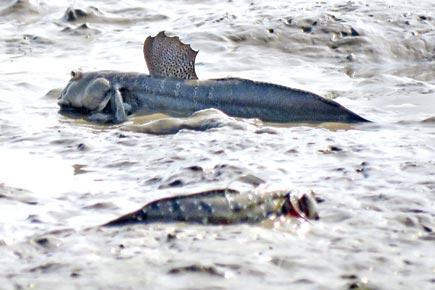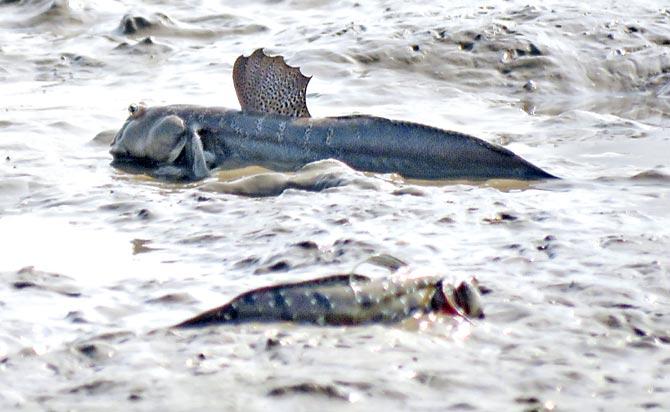Some fish can climb trees, it's true

Mudskippers are amphibious fish that can spend time on land
L ast month during the Heritage Walk organised by SPROUTS to Vasai fort, we took a group to a tall spire of one of the partially-restored churches. From this vantage point, soldiers used to keep an eye on any passing or approaching ship and sound an alarm if necessary. The swamps around the fort were covered by mangrove trees. Zigzagging streams led to the main creek. There was a lot of bird activity in the swamps and any walking Pond Heron and Reef Egret would result in some distinct movement.
ast month during the Heritage Walk organised by SPROUTS to Vasai fort, we took a group to a tall spire of one of the partially-restored churches. From this vantage point, soldiers used to keep an eye on any passing or approaching ship and sound an alarm if necessary. The swamps around the fort were covered by mangrove trees. Zigzagging streams led to the main creek. There was a lot of bird activity in the swamps and any walking Pond Heron and Reef Egret would result in some distinct movement.
We got curious to find out whether it was a snake or an eel. One of the kids borrowed my binoculars, and exclaimed, "Walking fish!" Although I had seen them with my naked eyes and knew exactly what they were, I checked again with the binoculars. This served two purposes, first was to maintain the scientific discipline of never concluding without checking. Through experience, we have realised that even stark amateurs can end up discovering rare creatures. The second purpose was to humour the kids and keep their sense of discovery alive. I pretended to study the curious creatures and remarked that these indeed were walking fish and that in fact, they could even climb trees. My intern Jayesh Vishwakarma informed them that they were fish popularly known as mudskippers.
ADVERTISEMENT

Mudskippers are amphibious fish that can spend time on land
It was hard for them to accept that the mudskippers were actually fish. Since their historical knowledge and science textbooks had taught them that fishes lived under water, it was hard for them to accept that the mudskippers were actually fish. Here they were jumping, walking and what seemed like 'basking' in the sun. We ventured towards the mangroves near the jetty entrance of the fort. Even the slightest movement by the kids led the mudskippers to hop-skip-and-jump towards the water or simply disappear into the marsh right before our eyes.
Mudskippers are part of a heterogeneous assemblage of sea-bottom fishes, classified under two genus, viz. Boleopthalamus and Periophthalmus. Most mudskippers are olive-green with blue markings on their body. Their eyes, situated at the top of the head, give them a panoramic view, which allows them to locate aerial predators. They possess well-developed eyelids sans tear glands. Hence, to moisten or clean the mud off their eyes, they simply roll their eyes backwards into the eye-sockets filled with water.
Modifications in their body structure help them move freely on land as well as in water, making them amphibious fish. Mudskippers are a wonderful example of the evolution of life from sea onto land. They breathe through their skin and the inner lining of their mouth and throat, which has a dense network of blood vessels. When a mudskipper ventures ashore, it carries a mouthful of water and air, giving them the liberty to remain out of water for prolonged periods.
Mudskippers move around in a series of skips using their pectoral (front) fins, resembling an Olympic sport Hop-Skip-and-Jump race. Some can even climb a few feet up mangrove trees. They forage on insects, sandworms and small crustaceans. A popular delicacy among Mumbai's locals, they are sold live in the fish markets next to jetties. Fishermen walk waist deep into the marshes to catch them. Next time you visit a mudflat, keep an eye for these aquatic Olympics champions.
Write in to Anand at sproutsenvttrust@gmail.com
 Subscribe today by clicking the link and stay updated with the latest news!" Click here!
Subscribe today by clicking the link and stay updated with the latest news!" Click here!







